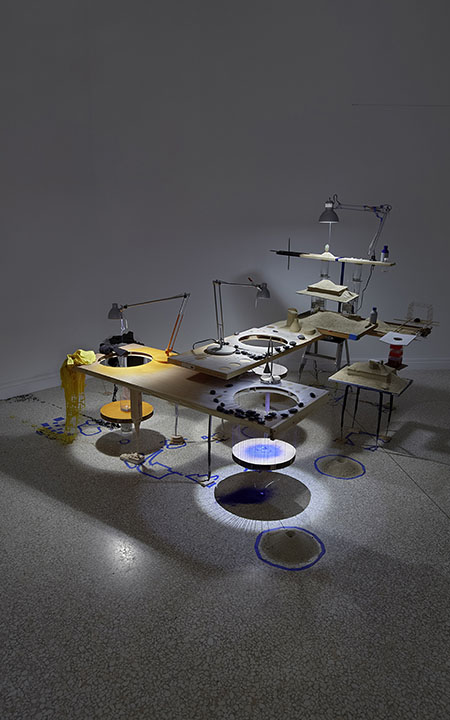The U.S Pavilion
The 55th Venice Biennale
The 55th Venice Biennale

The U.S. Pavilion – which was built by William Adams Delano and Chester Holmes Aldrich in 1930 – is not a good place for exhibiting art. The interior of the Palladian-style building feels like a series of lobbies or interstitial spaces that might lead to an actual gallery, but are themselves no entrance to a small provincial museum, where you might find the cloakroom, gift shop and ticket desk. A few nice landscapes of the Hudson Valley could work in these four galleries, but even then they would probably feel like distractions on the way to the museum coffee shop.
Sarah Sze seems to feel the same way too, judging from Triple Point, her installation for the 55th Biennale, commissioned by The Bronx Museum of the Arts in New York. She shifted the entrance from the central portico to the left-hand wing of the pavilion, creating a specific route for the visitor to follow. A wall in the other wing was removed to reveal a large window that had been installed during the 1970s, bringing some much-needed light to the pavilion. Her installation grows out across the exterior, covering the roof and small plaza immediately in front. Triple Point looks like it exists in defiance of the pavilion rather than in harmony with it; abandoned and gone to seed, covered with nests built from human detritus by some unnamed creature, like something from a J.G. Ballard story.

The substance of Sze’s installation is a series of sculptures made from objects she found in and around Venice. Finicky and fragile – each made from hundreds of tiny elements glued and balanced together – these works resemble models of distant galaxies that might have been built by Heath Robinson if he were a cosmologist. Their existence feels driven by a person with the need to communicate some ineffable understanding of the vast order of things that the rest of us can’t quite grasp; like Richard Dreyfuss compelled to endlessly sculpt the model of the mountain visited by friendly aliens in Close Encounters of the Third Kind (1977). Up close they remind me of moments in childhood when the imagination is free to let things at micro level stand for the macro; the tea stain that, if stared at long enough, becomes a lake, or the wood grain that becomes a series of roads.
In that general sense, I liked Triple Point but I’m too impatient for it. My eyes danced and bounced off each part but couldn’t find an anchor. These sorts of finely filigreed assemblages often leave me flat, like I’m being frantically spoken to by someone but can only hear sound rather than discern actual words. They become a picture of anarchic juxtaposition, or voluble hyper-connectedness, or whatever the artist is aiming at, rather than rewire me into some new state of ecstatic expressivity. (The experience in Venice, with each of Sze’s procession of fragile sculptures policed by worried-looking gallery assistants, did not help.)
[Missing Image]
Triple Point has much in common with some of the art included in Massimiliano Gioni’s curated exhibition, ‘The Encyclopedic Palace’: pictures and objects made by artists compelled to diagram their particular understanding of the universe in ways unencumbered by minimal cool or by-the-book Conceptual programmatics. The principal difference is that Sze’s work comes to us under the sign of professionalism; it is made by an artist with a ‘practice’ who is involved with observation and experimentation. Much of the work in Gioni’s show has found its way into the world as marginalia to art history, made by the self-educated, or individuals supposedly not quite as in control of their ideas as those with MFAs and gallery representation. It’s like making the distinction between astronomers and astrologists, only in the field of art we do not have the tools of physics and mathematics with which to prove that one group has more of a handle on truth than the other. In this sense, maybe Sze is making a good point.

























